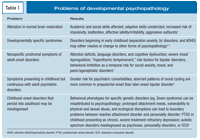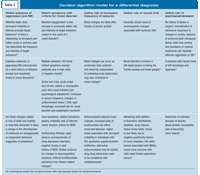Publication
Article
Psychiatric Times
The Differential Diagnosis of Childhood Developmental Disorders
Author(s):
Reducing complex human experiences into a psychiatric diagnosis can be a daunting task. For children with developmental disorders, this process is even more complicated and requires distilling often incomplete and frequently contradictory scientific evidence.
Reducing complex human experiences into a psychiatric diagnosis can be a daunting task. For children with developmental disorders, this process is even more complicated and requires distilling often incomplete and frequently contradictory scientific evidence. Table 1 lists several examples of the problems of developmental psychopathology. Although far from comprehensive, this list does raise 2 points:
- It is difficult to categorize psychopathological symptoms consistent with developmental disorders into discrete groups, such as organic or functional.
- Long-term outcomes for children with symptoms that suggest a severe developmental disorder are difficult to predict.
A case vignette provides a concrete example of these issues.
Case Vignette
JB is a 14-year-old African American boy with Down syndrome, moderate intellectual

disability, complex partial seizures, and sickle cell disease. He presents with a sudden onset of increased aggression, irritability, and self-injury 1 to 2 weeks after hospitalization for a sickle cell crisis. He experienced both severe pain and a cerebrovascular accident that resulted in apparent nonfluent aphasia, right-sided hemiparalysis, and a flurry of seizure activity. JB’s neurologist increased the dosage of levetiracetam, an anticonvulsant. Neurological imaging revealed a recent subcortical infarction in his left prefrontal cortex and caudate nucleus. He was referred to his primary care physician for depression 6 weeks after his hospitalization. She prescribed 20 mg of fluoxetine daily. Unfortunately the SSRI was associated with increased agitation, which the primary care doctor thought was drug-induced mania. The drug was withdrawn and the agitation abated. The patient was referred to a psychiatrist.
The differential diagnosis
Although an extreme example, this case illustrates the complexity of assessing children with developmental disorders. As with most referrals, this one also focused on an exacerbation of preexisting challenging behaviors. The primary care physician diagnosed depression but was alarmed by a sudden onset of what she felt was medication-induced mania and referred JB for a psychiatric evaluation.
Before embarking on a differential diagnosis for JB, several fundamental premises needed to be considered. A subset of developmental disorders, intellectual disability represents impairment in cognitive and adaptive skills. These deficits increase vulnerability to environmental changes and heighten the likelihood of intense, negative emotional reactions to these circumstances. Catastrophic reactions can be misattributed to mood disorders, or they may evolve into chronic conditions in the face of persistent stressors as when target behaviors (especially escape behaviors) are reinforced by significant others.1
Mood disorders are common in persons with Down syndrome. The differential diagnosis of depressive disorders requires ruling out thyroid disorders, sleep-related breathing disorders, folate and B12 deficiency, and the early phases of Alzheimer-like dementia.2,3 The presence of a chronic relapsing disorder such as sickle cell disease increases the risk for mood disorders (because of chronic pain, multiple hospitalizations, and limits on psychosocial development).4
Mood disorders develop in up to 40% of patients within a year after a cerebrovascular accident. Individuals who have had a left frontal-striatal stroke are vulnerable to both increased irritability and catastrophic reactions, as well as other symptoms consistent with major depressive disorders.5 Complex partial seizures are both predisposing and precipitating factors for mood disorders. Depressive disorders are more common among individuals with frequent complex partial seizures. This relationship is probably the result of compromised limbic function secondary to refractory seizures. Adverse effects from several anticonvulsants can also seriously limit social, academic, and occupational adjustments and contribute to this problem.6
The process of differential diagnosis begins by asking which of these factors contributed to the abrupt increase in JB’s agitation, explosive-aggressive behavior, and self-injurious behavior? The answer requires collecting detailed descriptions of his target symptoms from multiple sources and integrating medical and neurological information, psychological reports, functional behavioral analyses, and evidence from the psychiatric mental status examination. Once this information is gathered, the differential diagnosis follows a decision algorithm outlined in Table 2.
Making a diagnosis

Table 2 provides ample evidence for the multifactorial etiology of mental disorders in children with developmental disorders. The most parsimonious Axis I diagnosis is mood disorder due to medical conditions in the context of severe profound intellectual disability, sickle cell disease, cerebrovascular accident, complex seizure disorder, or Down syndrome. As discussed earlier, each of these medical conditions affects mood and illustrates the problem clinicians face in differentiating organic from functional psychiatric disorders in this population. The exacerbation of JB’s self-injurious behavior and aggression is probably related to mood changes and provides an example of the concept of baseline exaggeration.
General challenges
The assessment of psychiatric disorders is often limited by social and communication deficits, sensory impairments, as well as neurological and genetic/metabolic disorders. Because of these challenges, it is difficult to obtain sufficient data to define subtypes of mood disorders. In many situations, we are missing data that help establish the age at onset, pattern of onset, longitudinal course, severity and/or polarity, and other comorbid psychiatric disorders. Yet in spite of these diagnostic limitations, the prevalence rate of diagnosed psychiatric disorders in children with developmental disorders exceeds that of the general population.1
For clinicians the presence of behavioral phenotypes associated with specific genetic disorders can confound the differential diagnosis of psychiatric diagnosis. Problems arise because symptoms associated with several of these behavioral phenotypes overlap those of many psychiatric disorders. For example, persons with fragile X syndrome display social anxiety and gaze aversion that resemble autism. Variations in the dopamine DA4 receptors affect temperamental traits such as novelty seeking and risk-taking. For others, different alleles for specific genes regulating serotonin transporter proteins increase the risk for stress-induced mood and posttraumatic stress disorders. These gene-behavior relationships differ from the polygenic inheritance and complex behavioral symptoms associated with primary psychiatric disorders.7,8 Teasing out the nature of these relationships can permit clinicians to define subtypes of self-injurious behavior or aggression that might predict treatment response. A similar case can be built for differentiating specific endophenotypes of major psychiatric disorders.
The coexistence of autism spectrum disorders can also complicate things. For example, unwary clinicians can misattribute odd social behaviors during an interview as a manifestation of a severe mental disorder rather than a pervasive developmental disorder. Another clinician may elicit symptoms of severe mental illness but misattribute them as being “normal” for individuals with autism spectrum disorders (ie, all people with autism behave this way). A more insidious problem involves patients referred for medication management of mood or psychotic disorders without a differential diagnosis. The referring clinician cut short the differential diagnosis and made a provisional diagnosis based on a single symptom (eg, crying, sadness, insomnia, or hallucinations). Conversely, children are referred with a list of target symptoms but without additional data (sleep, mood, or social interests) that would assist in making a primary psychiatric diagnosis.1,9
Clinicians who successfully negotiate the differential diagnosis gauntlet still run into problems fitting the child into existing diagnostic criteria. The publication of the Diagnostic Manual for Intellectual Disabilities (DM-ID) represents a step toward resolving this problem.10 Although not yet validated by extensive field trials and statistical analysis, the DM-ID provides descriptive categorical criteria modified to accommodate across the spectrum of intellectual disabilities. But there are remaining problem areas. As the case vignette demonstrates, there is still considerable etiological diversity and clinical heterogeneity within psychiatric disorders. This diversity should remind us that most psychiatric disorders represent a final common pathway for multidirectional abnormalities of brain development and maturation.10
Conclusion
Determining a differential diagnosis is a process in which inclusion and elimination are used to narrow a range of presenting symptoms into a psychiatric disorder. However, because most child psychiatry referrals result from problematic behavior, the goal of melding these behaviors with diagnostic questions can be overlooked for children with potential developmental disorders. As a result, and as with much of child psychiatry, the differential diagnosis often involves translating target behaviors into symptoms. The diagnosis then results from synthesizing these data from multiple sources.
Ideally, behavioral specialists, mental health providers, family members, group home staff, primary care physicians, neurologists, and geneticists all contribute to a better understanding of the possible etiological and therefore diagnostic impressions in these complicated patients. The result of this synthesis is a biopsychosocial understanding of a child’s symptoms. Ultimately, this is the most effective means by which therapeutic guidelines can be developed. The work is by definition multidisciplinary and multisystemic, providing a true model for the collaborative care that children with developmental disorders need and deserve.
With increasing focus on community-based services for children with intellectual disabilities (IDs), it is quite likely that many psychiatrists will be called on to assess children and adults with ID and mental disorders. For many clinicians in the field, it is readily apparent that there is a dearth of treatment resources in many communities for patients with ID. There are even fewer resources for those with dual diagnoses. The American Association of Intellectual Disabilities has state and local branches that can provide referral assistance for individuals with ID. The National Association of Dual Diagnosis is an organization of professionals with expertise in both ID and mental disorders. Both organizations have Web sites that provide lists of providers. State Departments of Mental Health and Developmental Disability provide local services but all to often services are segregated in separate agencies.
References:
References
1. Harris JC. Intellectual Disability: Understanding Its Development, Causes, Classification, Evaluation, and Treatment. New York: Oxford University Press; 2006.
2. Burack JA, Weeks DJ. Research trends and innovations in the study of persons with Down syndrome and their families. J Intellect Disabil Res. 2007;51:
923-924.
3. Deb S, Hare M, Prior L. Symptoms of dementia among adults with Down’s syndrome: a qualitative study. J Intellect Disabil Res. 2007;51:726-739.
4. Beutler E. The sickle cell diseases and related disorders. In: Williams WJ, Beutler E, Erslev AJ, Lichtman MA. Hematology. New York: McGraw-Hill; 1990:613-643.
5. Robinson GR. The Clinical Neuropsychiatry of Stroke. Cambridge, UK: Cambridge University Press; 2006.
6. Ettinger AB, Kanner A, eds. Psychiatric Issues in Epilepsy: A Practical Guide to Diagnosis and Treatment. Philadelphia: Lippincott, Williams & Wilkins; 2001.
7. Levitas A, Dykens E, Finucane B, Kates W. Behavioral phenotype of genetic disorders. In: Fletcher R, Loeschen E, Stavrakaki C, First M, eds. Diagnostic Manual-Intellectual Disability. Kingston, NY: NADD Press; 2008:25-50.
8. Jones I, Craddock N. The genetic basis of bipolar disorder. Clin Approach Bipolar Disord. 2004;3:41-48.
9. Ursano AM, Kartheiser P, Barnhill LJ. Disorders usually first diagnosed in infancy, childhood, and adolescence. In: Hales RE, Yudovsky S, Gabbard DO, eds. Textbook of Psychiatry. 5th ed. Washington, DC: American Psychiatric Association Press; 2008:861-920.
10. Fletcher R, Loschen E, Stavrakaki C, First M, eds. Diagnostic Manual-Intellectual Disability: Textbook of Diagnosis of Mental Disorders in Persons With Intellectual Disability. Kingston, NY: NADD Press; 2007.
11. Witwer AN, Lecavalier L. Psychopathology in children with intellectual disability. J Mental Health Res Intellect Disabil. 2008;1:75-96.
12. Gardner WI, Griffiths D. Treatment of Aggressive and Related Disruptive Behaviors in Persons With Intellectual Disabilities and Mental Health Issues. Vol 1. Kingston, NY: NADD Press; 2004.
13. Robinson RG, Szetela B. Mood change following left hemispheric brain injury. Ann Neurol. 1981;8:447-453.
14. Shelley BP, Trimble MR, Boutros NN. Electroencephalographic cerebral dysrhythmic abnormalities in the trinity of nonepileptic general population, neuropsychiatric, and neurobehavioral disorders. J Neuropsychiatry Clin Neurosci. 2008;20:7-22.
15. Robinson RG. Mood disorders secondary to stroke. Semin Clin Neuropsychiatry. 1997;2:244-251.
16. Morrison MF, Kastenberg JS. Differentiation of secondary from primary mood disorders: controversies and consensus. Semin Clin Neuropsychiatry. 1997;2:232-243.
17. Gabriel S, Loschen E, Reeve A, et al. Mental disorders due to medical conditions not elsewhere classified. In: Fletcher R, Loschen E, Stavrakaki C, First
M, eds. Diagnostic Manual-Intellectual Disability. Kingston, NY: NADD Press; 2007:129-135.






